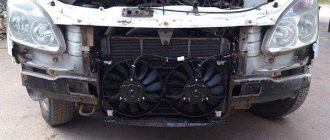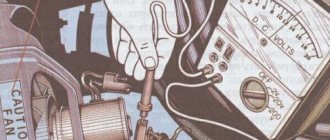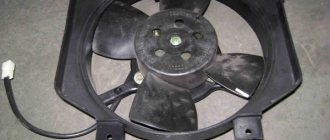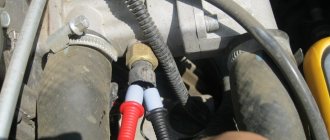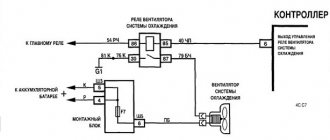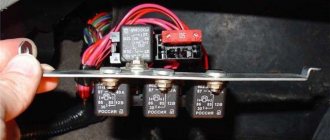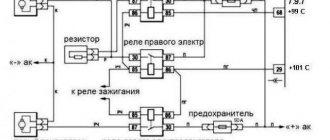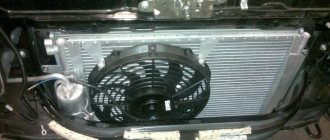The cooling of a car engine must always be efficient and effective. The VAZ 2114 is equipped with a liquid-cooled engine. Such a system is quite efficient and reliable, and cooling in it occurs due to the flow of liquid through a cooling radiator, which is cooled by a counter flow of air.
As you can see, such a system only works when the car is moving, but as soon as it stops, the radiator stops cooling, which leads to heating of the car engine. For such cases, the VAZ 2114, as well as other cars, is equipped with a special, powerful fan capable of creating an air flow no less than the oncoming air flow.
Quite often, this part on the VAZ 2114 refuses to work, which can lead to the engine boiling, which can cause serious damage to the engine.
This article talks about the engine cooling fan on the VAZ 2114, namely its purpose, causes of failure, the sensor that turns on the fan, methods of replacement and testing.
Purpose
The cooling fan is designed to cool the radiator with air, which it pumps with its impeller. Most often, the fan turns on in hot weather or when the car is stuck in a traffic jam, at these moments the fan is an indispensable part that keeps the engine from overheating.
What can happen to the engine if the cooling fan does not work:
- Due to severe overheating, the coolant may boil away and its level will drop significantly, which will reduce the engine cooling coefficient;
- Due to a significant increase in temperature, crankshaft liners and camshaft pastels, as well as valve seals, may be damaged;
- Possible occurrence of piston rings, both compression and oil scraper;
- Possible breakdown of the cylinder head gasket;
- Engine wedge;
As you can see, if the cooling fan does not work, this can lead to serious consequences, after which it will be necessary, if not a major, then a serious repair of the VAZ 2114 engine.
Design and principle of operation of the fan
Before you move on to repairing the fan, you should understand the principle of its installation on the cooling system. To do this, it is better to use the following simple diagram, on which the following main parts are indicated by numbers:
- — cooling radiator.
- - cork.
- - electric fan motor.
- - protective casing.
- - fan impeller.
- — damper pillows.
- - coolant drain plug.
In addition, a diagram of the electrical equipment of the cooling system, which looks like this, will also be very helpful in repairs:
As you can see, the start of the cooling fan is controlled by a relay, which starts after receiving a signal from the temperature sensor.
Once the liquid in the radiator reaches a certain temperature, the temperature sensor closes and thus triggers the fan to start.
Once the temperature of the liquid in the radiator drops below a certain point, the sensor will open and the fan will automatically turn off. But, as already mentioned, sometimes this does not always happen.
Why the VAZ 2114 cooling fan does not work
If the fan on a VAZ 2114 fails and does not turn on when the temperature is reached, then there may be several reasons, ranging from the most harmless to those that promise replacement of the fan itself: So, the reasons why the fan will not work:
- Problems with the fan switch sensor;
- The fan power fuse has blown;
- The relay coil is burnt out or the contacts are burnt;
- The fan connector is disconnected;
- The fan motor is burnt out;
As you can see, there are quite a few reasons why this part does not work, and in order to find the true problem it is necessary to check all the reasons step by step.
Fan fuse
To protect the electrical circuit of the VAZ 2114 cooling fan from short circuits and overloads, a fuse is used, in which, when the current in the circuit increases, the fuse link burns out, which leads to a break in this circuit.
The VAZ 2114 cooling fan fuse is located in the mounting fuse block under number F5 for 20A. Sometimes the fuse box in cars may be different and the fan fuse may be located under the number F7 at 30A.
Fan relay
The cooling fan is additionally protected using a relay that relieves the contact load on the sensor. A relay consists of a coil and contacts. Quite often, the contacts on the relay burn out or the coil winding burns out, which prevents the fan from turning on.
The relay is located on the auxiliary fuse box, which is located under the center console next to the engine control unit (ECU). In the picture the relay is marked with a red circle.
Fan switch sensor
To turn on the engine cooling fan, a special sensor is used that allows it to turn on automatically when a certain temperature is reached. The sensor is located in the thermostat housing and is installed there through a threaded connection with a special sealing washer.
Switch-on temperature
The cooling fan turns on on a working car at a temperature of 102.
Replacement
Tools:
- socket wrench 10;
- socket wrench 8;
- screwdriver with a Phillips bit.
Execution order
- We park the car on a flat surface and immobilize it with the parking brake.
- Open the hood and disconnect the negative terminal.
- Using a 10mm wrench, unscrew the fastenings of the air filter housing.
- Using a screwdriver, loosen the air duct clamp on the air flow sensor and remove the corrugation.
- We unscrew the screws securing the cover of the air filter housing and remove the filter element.
- Using a size 8 wrench, unscrew the air intake mount and remove it.
- Using a 10mm wrench, then an 8mm wrench, unscrew the nuts securing the fan casing around the perimeter (6 pieces in total).
- Disconnect the wire block on the fan connector.
- Carefully remove the fan casing along with the drive.
- Using a 10mm wrench, unscrew the 3 bolts holding the electric motor to the casing.
- We put a new one in its place.
- We install the structure in place, fix it, and connect the connector.
- We carry out further installation in the reverse order.
Diagnostics
The primary task is to identify the cause of the breakdown and assess your own capabilities in a specific situation.
Let's start with something simple and move on to something more complex:
- We check the fuse (F-7 with a voltage of 30 A), which is responsible not only for the heating system, but also for the operation of: the cigarette lighter, heated mirrors, glove compartment lights, and headlight washers. Therefore, when this fuse blows, all of the above devices refuse to work. If it is working, we move further along the chain.
- Turn on the car's ignition and switch the speed control to positions 1, 2, 3 in order. If the fan does not work in any of these positions, we move on.
- If the heater motor turns on after the car engine has warmed up, the problem is a faulty ignition relay. Solved by replacing the relay.
- If the heater motor refuses to work in any mode, there remains one malfunction - the heater motor itself.
The process of dismantling the fan motor
For the final verdict, let’s apply “+” directly to the motor by removing the positive wire terminal from the motor. If the motor does not come to life, the last thing you can try is to try to clean the place under the ground mount on the electric motor. Often this place oxidizes and the contact weakens.
Reasons for fan failure
There are a number of reasons why the fan sensor can eventually fail other than the sensor itself. Therefore, they should first be excluded to make sure that the sensor is to blame.
Reasons for fan failure include:
- The fan has failed. It can wear out, lose integrity, and receive mechanical damage. It will be more expensive to replace it compared to the sensor, but there is no choice.
- The chain has broken. When testing a sensor, the method of closing two of its contacts is usually used. But if the wiring circuit is damaged, this will not be possible, and due to inexperience, all the blame will be placed on the regulator.
If checking the contacts does not produce results, the fan does not respond, try connecting its contacts directly to the battery.
Sensor check
First, we advise you to check the sensor that you think is faulty. Even if it turns out that it doesn't really work, at least you'll have peace of mind.
Plus, be sure to check the new sensor before installing it. This will make sure it works. Today there are quite a lot of fakes on the market, so there is always a chance to purchase a low-quality fan sensor.
Searched object
To check you will need a certain set of tools and materials, which includes:
- Capacity;
- Water;
- Coolant;
- Thermometer;
- Multimeter.
Let's start checking.
- Pour water or regular coolant into the prepared container.
- Lower the sensor into it with the threaded part.
- Connect the multimeter terminal to the regulator contacts. The measuring device must be in resistance measurement mode. Although if the multimeter has a dialing function, then choose it.
- Place a thermometer into the liquid.
- Heat the water.
- When the liquid temperature reaches the regulator response temperature (92 degrees Celsius), the contacts should close and the multimeter will start beeping.
- If this does not happen, the sensor really does not work and needs a replacement.
If you purchased a regulator that is not working, be sure to go to the store and ask for a replacement or refund. But only if you have a receipt. It is better to purchase spare parts in specialized, good stores. There is less risk of getting caught by a fake.
How to perform a check on injection VAZ cars
It is quite possible that this can also be done on other cars, but I will not vouch for the result, since I tested it with personal experience only on domestic injection cars VAZ (2109-2115), Kalina, Priora, etc.
To quickly check whether your fan is working or not, just follow these steps:
- open the hood of your car
- turn on the ignition
- we find the coolant temperature sensor (most often it is located on the thermostat housing)
- disconnect the electrical connector from it
DTOZH VAZ
If the fan motor is working properly, it should turn on immediately when you remove the “terminal” from the sensor. If this does not happen, then the fan is faulty.
Yes, you can, of course, remove the connector directly from the fan itself and check everything using the battery power supply, but you must agree that this is a much more labor-intensive process than removing the connector from the temperature sensor.
Additional recommendations
If desired, you can install an additional button that will forcefully start and stop the fan.
VAZ 2114 fan diagram with a button
In order to do this, you will need:
- purchase a button (or toggle switch) and mount it in any convenient place (you can even under the hood);
- make a branch from the wire coming from the battery positive to the fan relay, soldering another wire to it;
- connect this wire to the first contact of the button;
- connect the second contact of the button to the relay leg, from which the “positive” wire goes to the fan.
Thanks to such a simple circuit, it will be possible to control the operation of the fan manually.
Conclusions: what exactly should be done if the fan does not work (action algorithm)
First, check whether the “plus” is connected to one of the terminals in the connector. Then connect the connector from ground to check the serviceability of the electric motor. In some cases, you can observe this:
- Both fuse F5 and the additional fuse are working;
- The fan relay operates as expected;
- The DTOZh sensor is working;
- The motor can only be turned on by applying a potential of “0 Volt”.
There will be only one conclusion: the ground contact has come loose, which ends the entire power line. This means you will need to contact an auto electrician. All other faults can be overcome by yourself.
Element F5 may burn out as a result of the horn closing. But then “+12” is not called up on the connector, which should immediately alert you.


